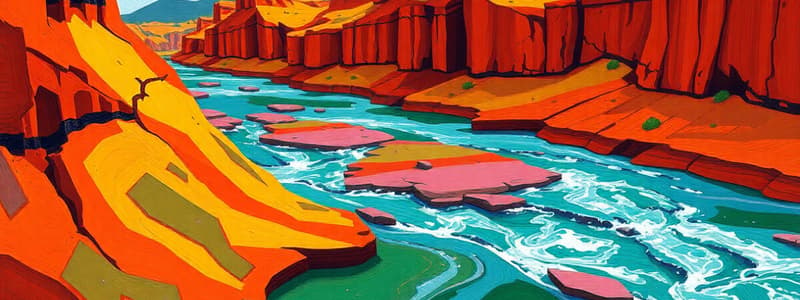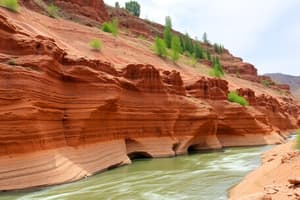Podcast
Questions and Answers
What is formed when a river erodes through the meander neck?
What is formed when a river erodes through the meander neck?
- Oxbow Lake (correct)
- Levee
- Delta
- Headland
What causes deposition to occur on the inside of a river bend?
What causes deposition to occur on the inside of a river bend?
- Fast-flowing water
- Erosion
- Wave action
- Slow-flowing water (correct)
How are levees primarily formed?
How are levees primarily formed?
- By wave action on coastal rocks
- By river water draining into the ocean
- By natural erosion of cliffs
- By floodwaters depositing sand and silt (correct)
What happens to a river's energy when it meets a larger body of water, such as a sea or lake?
What happens to a river's energy when it meets a larger body of water, such as a sea or lake?
Which of the following features is a result of wave erosion?
Which of the following features is a result of wave erosion?
Which component is critical in the formation of headlands and bays?
Which component is critical in the formation of headlands and bays?
What remains after an oxbow lake dries up?
What remains after an oxbow lake dries up?
What results from the relentless pounding of ocean waves on the coastline?
What results from the relentless pounding of ocean waves on the coastline?
What process leads to the formation of an arch around a headland?
What process leads to the formation of an arch around a headland?
How is longshore drift defined in coastal processes?
How is longshore drift defined in coastal processes?
What feature is formed when a spit grows across a bay?
What feature is formed when a spit grows across a bay?
Which of the following correctly describes a stack?
Which of the following correctly describes a stack?
What can result from the deposition of materials eroded from headlands?
What can result from the deposition of materials eroded from headlands?
What usually happens when water becomes trapped behind a spit?
What usually happens when water becomes trapped behind a spit?
What role do waves play in the erosion of coastal features?
What role do waves play in the erosion of coastal features?
Which statement about beaches is incorrect?
Which statement about beaches is incorrect?
What primarily causes the formation of meanders in a river?
What primarily causes the formation of meanders in a river?
Which factor leads to a river's load gradually decreasing in size as it approaches the sea?
Which factor leads to a river's load gradually decreasing in size as it approaches the sea?
What creates a gorge through river erosion?
What creates a gorge through river erosion?
How are levees primarily formed?
How are levees primarily formed?
What happens to the sediment load as a river enters its lower course?
What happens to the sediment load as a river enters its lower course?
Which characteristic best differentiates a canyon from a gorge?
Which characteristic best differentiates a canyon from a gorge?
In a river network, what typically occurs in deltas?
In a river network, what typically occurs in deltas?
Which of the following statements about wave erosion is true?
Which of the following statements about wave erosion is true?
Flashcards are hidden until you start studying
Study Notes
River Processes
- Deposition: Occurs when water flows slower, typically on the inside of a river bend.
- Erosion: Occurs when water flows faster, typically on the outside of a river bend.
Ox-bow Lakes
- Formation: Created when erosion continues and narrows the gap between meanders, known as the meander neck. The river erodes through the neck, creating a new channel, leaving the original meander isolated as an ox-bow lake.
- Meander Neck: The narrow gap between meanders.
- Meander Scar: The dried-up remains of an ox-bow lake.
Levees
- Formation: Natural mounds on river banks formed by sediment deposition during floods.
- Height: Increased by frequent floods.
Deltas
- Formation: Occur when rivers flow into seas or lakes. The decrease in river energy causes sediment deposition.
Wave Erosion
- Energy: Ocean waves possess significant energy that erodes the land.
- Erosion Rate: Waves cause greater erosion during storms and strong winds.
Headlands and Bays
- Formation: Caused by the different erosion rates of rocks with varying hardness. Waves erode softer rock faster, creating bays.
- Headlands: Pieces of land that stick out into the sea, composed of harder rock.
- Bays: Indented areas between headlands, composed of softer rock.
Cliffs
- Formation: Steep rock walls formed by wave erosion.
- Wave-Cut Hollow: Underwater erosion at the base of cliffs weakens them, leading to collapses.
- Wave-Cut Platform: The eroded base of a cliff left behind as the cliff face retreats inland.
Caves, Arches and Stacks
- Sequence: Formed by a sequential process of wave erosion over long periods.
- Caves: Formed by waves eroding weak points in cliffs.
- Arches: Formed when two caves on opposing sides of a headland meet.
- Stacks: Formed when arches collapse, leaving isolated columns of rock.
Wave Deposition
- Source: Material eroded from headlands is transported by waves and currents.
- Beaches: Areas of loose sand or stones deposited along the coast, between low and high tide.
Longshore Drift
- Movement: Waves push material up the beach at an angle, causing it to roll down at a different angle.
- Transportation: Material eroded from headlands and deposited by rivers can be transported along the coast by longshore drift.
Spits
- Formation: Narrow ridges of sand extending out into the sea or river mouth, formed by longshore drift.
- Growth: Continue to grow until deposition is halted by changes in currents or obstacles like rivers.
- Salt Marshes: Areas of mud and plants formed when water is trapped behind a spit.
Bars
- Formation: Occur when spits grow completely across a bay, joining two headlands.
- Lagoons: Bodies of water trapped behind bars.
- Salt Marshes: Lagoons can eventually become salt marshes.
Ice Erosion
- Glaciers: Masses of ice that move slowly downhill, eroding the land.
River Erosion
- Load: Rivers carry a mixture of weathered material, including sand, stones, and silt.
- Erosion: The river’s load wears away at the riverbed and sides.
- Load Size: The size of the load decreases as the river flows towards the sea.
Upper Course
- Flow: Rivers flow faster on steep land.
- Load: Faster-flowing rivers can transport heavier and larger loads.
- Downward Erosion: The movement of boulders and rocks along the riverbed causes deepening, forming valleys with steep sides.
Waterfalls and Rapids
- Waterfalls: Sudden drops in a river’s gradient.
- Rapids: Fast-flowing sections of the river without a sudden drop in height.
- Formation: Occurs where the river flows over alternating bands of hard and soft rock.
Gorges and Canyons
- Formation: Deep-sided valleys carved by downward river erosion.
- Gorges: Usually straighter and linked to waterfalls.
- Canyons: Often wider, formed by increased downward erosion due to factors like a drop in sea level or land uplift.
Middle and Lower Course
- Sideways Erosion: More prominent in the middle and lower courses.
- Erosion and Deposition: Erosion widens river valleys, while deposition adds to the river’s load.
- Meanders: Large bends in the river.
Meanders
- Erosion: The faster flow on the outside of the bend causes erosion.
- Deposition: Slower flow on the inside of the bend causes deposition.
Studying That Suits You
Use AI to generate personalized quizzes and flashcards to suit your learning preferences.



